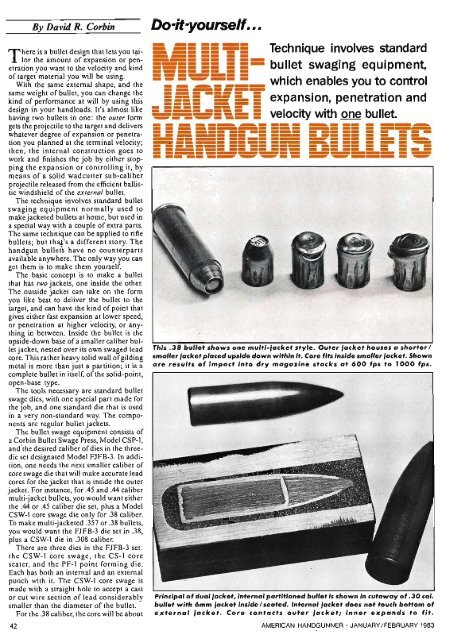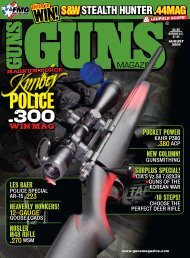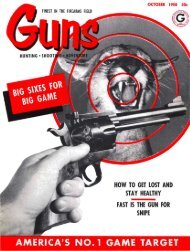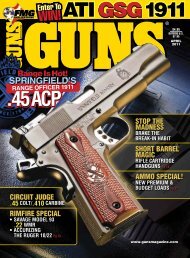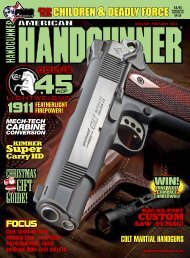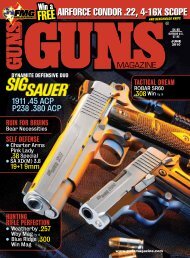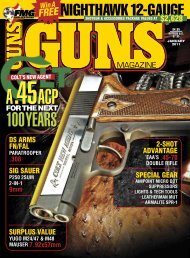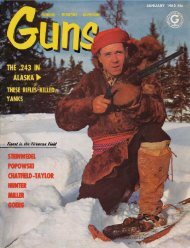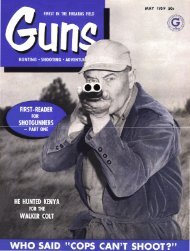NEW! - Jeffersonian
NEW! - Jeffersonian
NEW! - Jeffersonian
Create successful ePaper yourself
Turn your PDF publications into a flip-book with our unique Google optimized e-Paper software.
By David R. Corbin<br />
There is a bullet design that lets you tailor<br />
the amount of expansion or penetration<br />
you want to the velocity and kind<br />
of target material you will be using.<br />
With the same external shape, and the<br />
same weight of bullet, you can change the<br />
kind of performance at will by using this<br />
design in your handloads. It's almost like<br />
having two bullets in one: the outer form<br />
gets the projectile to the target and delivers<br />
whatever degree of expansion or penetration<br />
you planned at the terminal velocity;<br />
then, the internal construction goes to<br />
work and finishes the job by either stopping<br />
the expansion or controlling it, by<br />
means of a solid wadcutter sub-caliber<br />
projectile released from the efficient ballistic<br />
windshield of the external bullet.<br />
The technique involves standard bullet<br />
swaging equipment normally used to<br />
make jacketed bullets at home, but used in<br />
a special way with a couple of extra parts.<br />
The same technique can be applied to rifle<br />
bullets; but tha+,s a different story. The<br />
handgun bullets have no counterparts<br />
available anywhere. The only way you can<br />
get them is to make them yourself<br />
The basic concept is to make a bullet<br />
that has two jackets, one inside the other.<br />
The outside jacket can take on the form<br />
you like best to deliver the bullet to the<br />
target, and can have the kind of point that<br />
gives either fast expansion at lower speed,<br />
or penetration at higher velocity, or anything<br />
in between. Inside the bullet is the<br />
upside-down base ofa smaller caliber bullet<br />
jacket, nested over its own swaged lead<br />
core. This rather heavy solid wall ofgilding<br />
metal is more than just a partition; it is a<br />
complete bullet in itself, ofthe solid-point,<br />
open-base type.<br />
The tools necessary are standard bullet<br />
swage dies,with one special part made for<br />
the job, and one standard die that is used<br />
in a very non-standard way. The components<br />
are regular bullet jackets.<br />
The bullet swage equipment consists of<br />
a Corbin Bullet Swage Press, Model CSP-I,<br />
and'the desired caliber ofdies in the threedie<br />
set designated Model FJFB-3. In addition,<br />
one needs the next smaller caliber of<br />
core swage die that will make accurate lead<br />
cores for the jacket that is inside the outer<br />
jacket. For instance, for .45 and .44 caliber<br />
multi-jacket bullets, you would want either<br />
the .44 or .45 caliber die set, plus a Model<br />
CSW-l core swage die only for .38 caliber.<br />
To make multi-jacketed .357 or .38 bullets,<br />
you would want the FJFB-3 die set in .38,<br />
plus a CSW-l die in .308 caliber.<br />
There are three dies in the FJFB-3 set:<br />
the CSW-I core swage, the CS-I core<br />
seater, and the· PF-I point forming die.<br />
Each has both an internal and an external<br />
punch with it. The CSW-l core swage is<br />
made with a straight hole to accept a cast<br />
or cut wire section of lead considerably<br />
smaller than the diameter of the bullet.<br />
For the.38 caliber, the core will be about<br />
42<br />
Do-if-yourself...<br />
_. - ------ -----<br />
----- ---<br />
-------<br />
------- ---_..--<br />
~--~_..._-<br />
---- -_..- - -<br />
_-...~- --------<br />
-----------<br />
- - .<br />
- -- ------ -.-.. ~--<br />
Technique involves standard<br />
bullet swaging equipment,<br />
which enables you to control<br />
expansion, penetration and<br />
velocity with one bullet.<br />
---- ----- ---- -_..-..<br />
--------<br />
- - - - -<br />
~~ -..-r<br />
-------<br />
This .38 bullet shows one multi-;acket style. Outer ;acket houses a shorter/<br />
smaller;acket placed upside down within it. Core fits inside smaller ;acket. Shown<br />
are results of impact into dry magazine stacks at 600 fps to J000 fps.<br />
Principal ofdual ;acket, internal partitioned bullet is shown in cutaway of.30 cal.<br />
bullet with 6mm ;acket inside / seated. Internal ;acket does not touch bottom of<br />
external ;acket. Core contacts outer ;acket; inner expands to fit.<br />
AMERICAN HANDGUNNER ' JANUARYIFEBRUARY 1983


